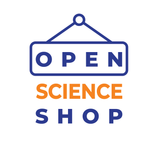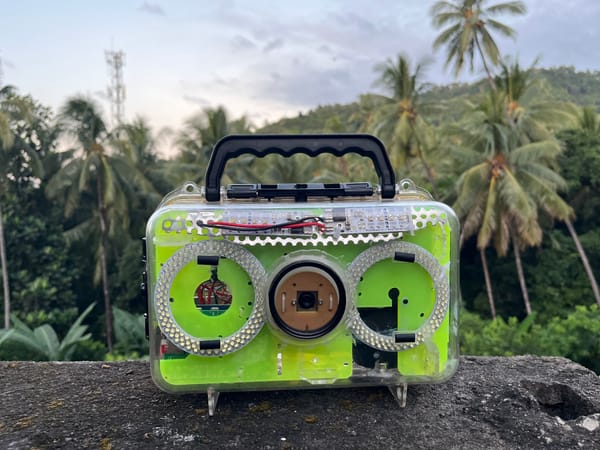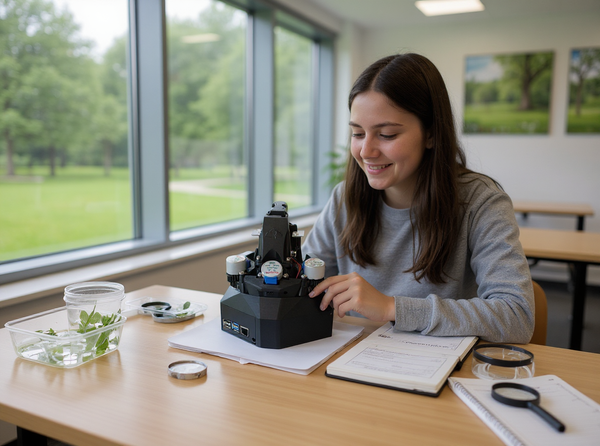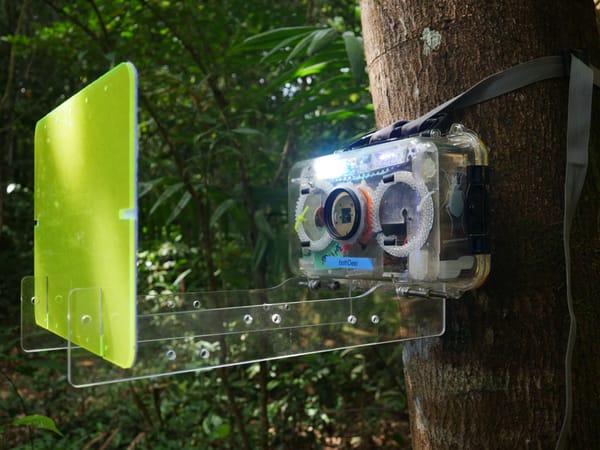Exploring strategies for extending use of open hardware in K-12 schools
This draft concept paper was written as a way of initiating dialog between open hardware companies and educators about potential synergies that might be developed.
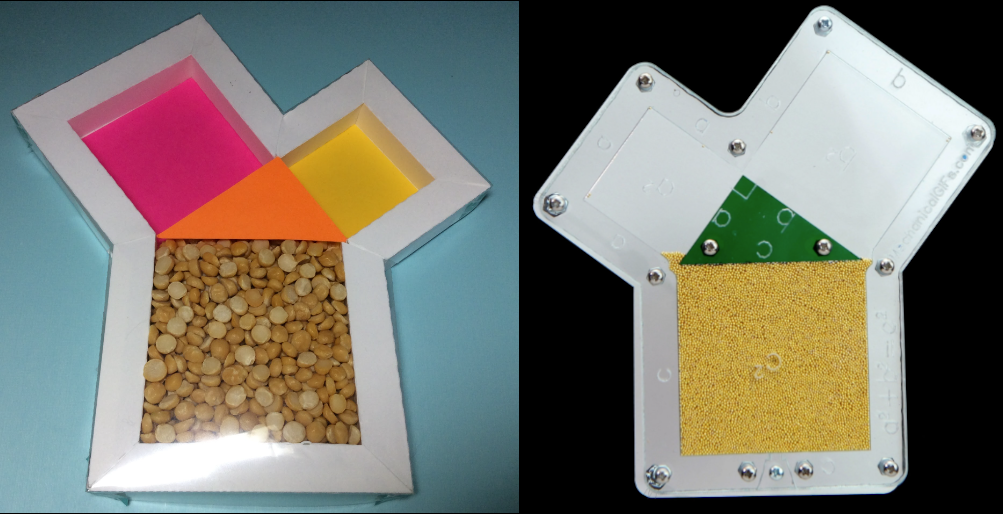
Written by Glen Bull, Joanne Long, and Steven Greenstein for the Open Science Shop newsletter
Open hardware is defined as hardware whose design is made free and publicly available for others to make, modify, and distribute (see OSHWA). The hardware’s source can be made available in any number of a variety of formats, such as CAD and STL files. The use of open hardware in education is a promising development, because it offers teachers new access to educational tools they can use to support their students’ learning. Indeed, students can learn concepts more deeply when they have the opportunity to engage in hands-on experimentation with physical objects such as manipulatives in mathematics education, experimental apparatus in science education, and physical gear trains in engineering projects. This vision of democratized access to effective hands-on learning experiences for every student at every grade level is consistent with the mission of the open-source community.
Increasing Access to Open Hardware
Open hardware use is rapidly expanding, although this growth is primarily occurring at the postsecondary level (Heradio, et al., 2018). At the K-12 school level, the increasing presence of makerspaces and digital fabrication equipment (e.g., 3D printers, laser cutters) is making it possible for educators to take advantage of these new opportunities. However, growth is slower at this level due to constraints such as the limited number of staff who have the time and expertise to run this equipment and produce enough educational objects for a complete classroom set.
Fortunately, there are other strategies for extending the use of open hardware to schools that could be explored:
- Fabrication Laboratories (or “Fab Labs”) are small-scale operations that offer digital fabrication services and experiences. Given their commitment to democratizing access to these technologies, Fab Labs may be interested in collaborating with schools in their community to provide production capacity that meets the needs of classroom teachers.
- A second potential strategy is for high school technology and engineering classes to implement projects where their students learn how to operate these fabrication technologies as they work alongside classroom teachers to manufacture the objects they need. The International Technology and Engineering Education Association (ITEEA) is actively exploring ways in which its widely adopted Engineering by Design curriculum can be adapted to encourage collaborations between high school engineering students and teachers.
- A third possibility is the establishment of partnerships between schools and any of an emerging class of open-source hardware companies. Open-source hardware companies have the staff, tools, and expertise that uniquely position them to manufacture and ship larger quantities of educational objects, such as scientific apparatus and instruments. They are also likely to adhere to standards and guidelines set forth by the Open-Source Hardware Association (OSHWA) that ensure fidelity in terms of shareability and quality design. In addition, these companies make their designs free and publicly available, making them a reliable resource for teachers who need a classroom set of multiple copies of an educational object.
These strategies for supporting and promoting the use of open hardware in schools present a continuum of possibilities. Fabrication of a single object in a school makerspace for a classroom demonstration or student learning anchors one end of the continuum. This option may be the right choice for a teacher who is exploring the potential of a tool for teaching and wishes to assess its efficacy in their instruction. Anchoring the other end of the spectrum are open hardware companies that have the bandwidth and infrastructure to produce multiple copies of the device. This option may be the right choice for a teacher who wishes to produce a classroom set of these tools once they’ve proven effective for supporting students’ learning. It may also be the right choice for a department that decides to integrate the tool’s use into their curriculum and scale up that integration across an entire school or even across an entire district.
Pathways to Open-Source Ecosystems
Through its Pathways to Enable Open-Source Ecosystems (POSE) program, the National Science Foundation is funding initiatives that harness the power of open-source development to catalyze innovative technological solutions to problems of national and societal importance. Consistent with its vision of ensuring a broader and more diverse adoption of open-source products, the program recently funded a POSE grant (NSF #2229627) designed to identify methods of building a sustainable ecosystem consisting of a community of developers and educators working together to identify effective ways of increasing the use of open hardware in schools (Bull, et al., 2023). The National Technology Leadership Summit (NTLS) coalition, a consortium of twelve national teacher educator associations, is participating in this initiative. Participating associations include ITEEA, the Association for Science Teacher Education (ASTE), and the Association of Mathematics Teacher Educators (AMTE).
Recently ITEEA, ASTE, and AMTE jointly announced the launch of the first peer-reviewed Educational CAD Model Library (www.CADLibrary.org) at the 24th National Technology Leadership Summit (NTLS), held at the headquarters of the National Education Association in Washington, D.C. on September 14, 2023.
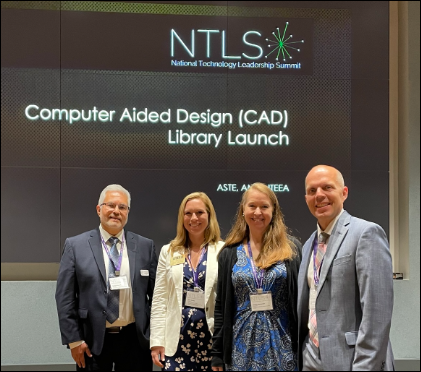
The purpose of the CAD Library is to provide educators with a source of peer-reviewed open educational objects to be used in teaching, as described above. The educational objects in the library are licensed under a Creative Commons Attribution-NonCommercial 4.0 International License. The CAD Library is a work in progress at this stage and is still under development.
Exploring Collaborations between Educators and Open Hardware Companies
Educators from participating NTLS associations are interested in engaging in conversations with developers from open hardware companies that would like to jointly explore the development of an open-source ecosystem to facilitate the use of open hardware in schools. A potential use case follows.
One of the objects in the CAD Library is a Pythagorean Theorem model developed by mathematics teacher, Elaine Wolfe. Elaine’s open-source design (see Figure 2, left) can be fabricated using construction paper and scissors, making it possible to be created with readily available materials. Since teachers may not have the bandwidth to fabricate a classroom set of 20 or 25 models , the acquisition of multiple copies of a commercial counterpart made from laser-cut acrylic sold by Theodore Gray offers an alternative (see Figure 2, right).
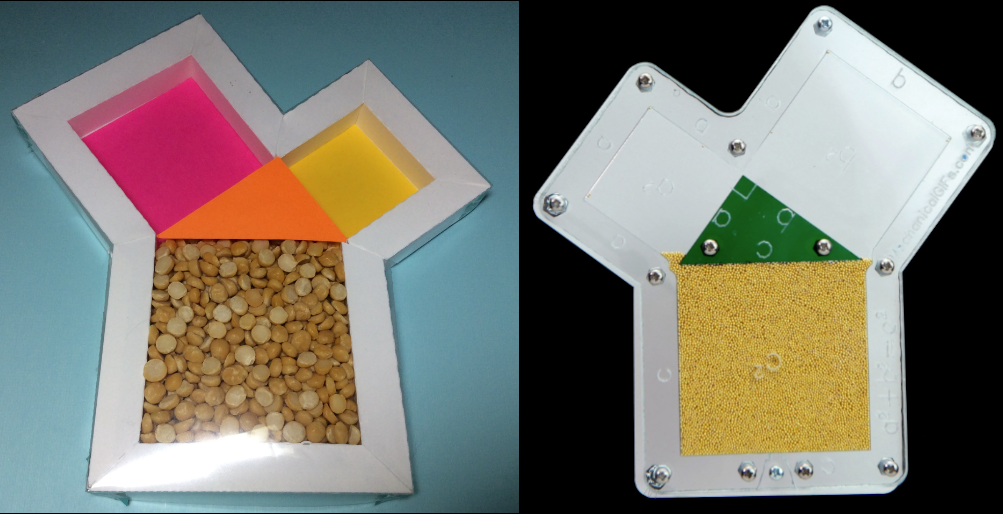
Designs such as these in the CAD Library could enable teachers to create and test a model or instrument using a school makerspace or Fab Lab. If the pilot use seems promising, the school could then order additional copies from an open-source hardware company.
At this time, the potential scalability or sustainability of the fabrication strategies described is unknown. As a first step, we would like to identify developers from open-source companies who are interested in conversations with educators about developing small-scale pilots designed to evaluate the feasibility of such strategies. Open Hardware companies and manufacturers are encouraged to contact Glen Bull (gbull@virginia.edu) or Joanne Long (jo@iorodeo.com) to schedule a Zoom conversation to discuss next steps.
References
Bull, G., Shapiro, D., Cohen, J., Borowczak, A., Galindo, E., Lassiter, S., & Slykhuis, D. (2023). Establishing an educational CAD model ecosystem. Contemporary Issues in Technology and Teacher Education, 23(3), 393-413.
Heradio, R., Chacon, J., Vargas, H., Galan, D., Saenz, J., Torre, L. D. L., & Dormido, S. (2018) “Open-Source Hardware in Education: A Systematic Mapping Study,” in IEEE Access, vol. 6, pp. 72094-72103. doi: 10.1109/ACCESS.2018.2881929.
This draft concept paper was written as a way of initiating dialog between open hardware companies and educators about potential synergies that might be developed.
Acknowledgements
Since 2010 this work has been supported with a series of National Science Foundation awards (NSF #1030865, 2010–2015; #151308, 2015-2019; 1842342, 2018-2022; 2229627, 2022-24).
About Authors
Glen Bull is a professor of education in the School of Education and Human Development at the University of Virginia. He is currently director of the Make to Learn Laboratory at the University of Virginia.
Joanne Long is a co-founder of IO Rodeo in Pasadena, California. Before co-founding IO Rodeo, Jo spent several years working alongside science teachers to develop hands-on educational technology labs for middle school classrooms. She observed that while well-resourced schools were able to afford expensive, commercially manufactured equipment, school districts with fewer resources had limited access. Increasing access to affordable, open science hardware in K12 classrooms is one of IO Rodeo's goals. Products offered by IO Rodeo are Open Hardware certified by OSHWA.
Steven Greenstein is an Associate Professor of Mathematics Education at Montclair State University in New Jersey (link to bio). He is the curator of the Mathematics Collection of the Educational CAD Model Library. Through his teaching and research, Steven seeks to determine and support the tools and practices with which educators can democratize access to authentic mathematical activity that honors the diversity of learners’ mathematical thinking and that is guided by self-directed and agentive inquiry, mathematical play, and the pursuit of wonderful ideas.
